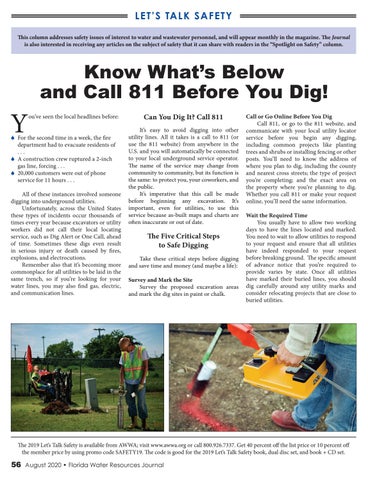L ET’ S TA LK S A FE TY This column addresses safety issues of interest to water and wastewater personnel, and will appear monthly in the magazine. The Journal is also interested in receiving any articles on the subject of safety that it can share with readers in the “Spotlight on Safety” column.
Know What’s Below and Call 811 Before You Dig!
Y
ou’ve seen the local headlines before:
S F or the second time in a week, the fire department had to evacuate residents of ... S A construction crew ruptured a 2-inch gas line, forcing . . . S 2 0,000 customers were out of phone service for 11 hours . . . All of these instances involved someone digging into underground utilities. Unfortunately, across the United States these types of incidents occur thousands of times every year because excavators or utility workers did not call their local locating service, such as Dig Alert or One Call, ahead of time. Sometimes these digs even result in serious injury or death caused by fires, explosions, and electrocutions. Remember also that it’s becoming more commonplace for all utilities to be laid in the same trench, so if you’re looking for your water lines, you may also find gas, electric, and communication lines.
Can You Dig It? Call 811 It’s easy to avoid digging into other utility lines. All it takes is a call to 811 (or use the 811 website) from anywhere in the U.S. and you will automatically be connected to your local underground service operator. The name of the service may change from community to community, but its function is the same: to protect you, your coworkers, and the public. It’s imperative that this call be made before beginning any excavation. It’s important, even for utilities, to use this service because as-built maps and charts are often inaccurate or out of date.
The Five Critical Steps to Safe Digging Take these critical steps before digging and save time and money (and maybe a life): Survey and Mark the Site Survey the proposed excavation areas and mark the dig sites in paint or chalk.
Call or Go Online Before You Dig Call 811, or go to the 811 website, and communicate with your local utility locator service before you begin any digging, including common projects like planting trees and shrubs or installing fencing or other posts. You’ll need to know the address of where you plan to dig, including the county and nearest cross streets; the type of project you’re completing; and the exact area on the property where you’re planning to dig. Whether you call 811 or make your request online, you’ll need the same information. Wait the Required Time You usually have to allow two working days to have the lines located and marked. You need to wait to allow utilities to respond to your request and ensure that all utilities have indeed responded to your request before breaking ground. The specific amount of advance notice that you’re required to provide varies by state. Once all utilities have marked their buried lines, you should dig carefully around any utility marks and consider relocating projects that are close to buried utilities.
The 2019 Let’s Talk Safety is available from AWWA; visit www.awwa.org or call 800.926.7337. Get 40 percent off the list price or 10 percent off the member price by using promo code SAFETY19. The code is good for the 2019 Let’s Talk Safety book, dual disc set, and book + CD set.
56 August 2020 • Florida Water Resources Journal


















